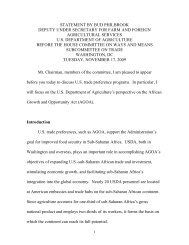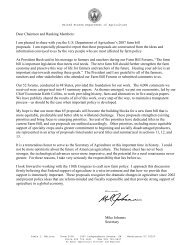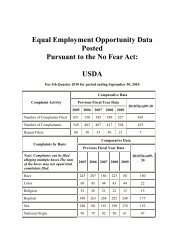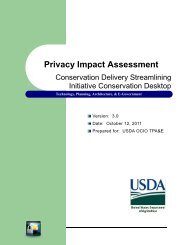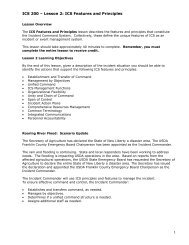2012 Weather Review: Heat and Drought Hit Eurasia
2012 Weather Review: Heat and Drought Hit Eurasia
2012 Weather Review: Heat and Drought Hit Eurasia
Create successful ePaper yourself
Turn your PDF publications into a flip-book with our unique Google optimized e-Paper software.
<strong>2012</strong> <strong>Weather</strong> <strong>Review</strong>:<strong>Heat</strong> <strong>and</strong> <strong>Drought</strong> <strong>Hit</strong> <strong>Eurasia</strong>USDA Agricultural Outlook ForumFebruary 22, 2013Eric LuebehusenMeteorologisteluebehusen@oce.usda.gov202-720-3361
US <strong>Heat</strong> <strong>and</strong> <strong>Drought</strong> havebeen the BIG Story
But we were not alone…
How did it all unfold?What areas <strong>and</strong> cropswere impacted?
Spring, <strong>2012</strong>In the spring, <strong>2012</strong>, near‐ to above‐normal rainfallacross most major growing areas seemed to pointtoward favorable winter <strong>and</strong> summer crop prospects.There were a few exceptions, most notably in northcentralEurope <strong>and</strong> in southwestern Russia.
Summer, <strong>2012</strong>However, a much drier‐than‐normal summerimpacted crops from southern Europe into central<strong>and</strong> eastern Russia. Areas hardest hit included cornin Italy, Romania, <strong>and</strong> Bulgaria, as well as springwheat in Russia’s Siberia District. Dry weather late inthe summer also trimmed corn yield expectations insouthwestern France after a favorable start.
Summer, <strong>2012</strong>A closer look revealssummer drynesslined up with mostof the EU’s primarycorn areas.Corn
Italy: Po River ValleyCumulative Precipitation, June 1 – August 31Little if any rain fell during moisturecriticalstages of development, keepingirrigation dem<strong>and</strong>s highTassel/SilkFill
Southern RomaniaCumulative Precipitation, June 1 – August 31With no irrigation available, droughtrapidly took a toll on Balkans’ cornTassel/SilkFill
Southeast BulgariaCumulative Precipitation, June 1 – August 31With no irrigation available, droughtrapidly took a toll on Balkans’ cornTassel/SilkFill
Summer, <strong>2012</strong>Corn<strong>Heat</strong> was also an issue;95‐degree days werecommon in southernEurope’s Corn Belt
Italy – Po River ValleyDays at or above 95°FJune 1 – August 31, 1980-<strong>2012</strong>2 nd Most:35 Days(10 Avg)CornAvg
Southern RomaniaDays at or above 95°FJune 1 – August 31, 1980-<strong>2012</strong>Most:45 Days(18 Avg)CornAvg
Northern BulgariaDays at or above 95°FJune 1 – August 31, 1980-<strong>2012</strong>Tied –Most44 Days(15 Avg)CornAvg
Southeast BulgariaDays at or above 95°FJune 1 – August 31, 1980-<strong>2012</strong>Most:35 Days(10 Avg)CornAvg
Summer, <strong>2012</strong>Even more alarmingwas the frequency of100‐degree heat,especially in theBalkans.Corn
Southern RomaniaDays at or above 100°FJune 1 – August 31, 1980-<strong>2012</strong>Most:25 Days(5 Avg)CornAvg
Northern BulgariaDays at or above 100°FJune 1 – August 31, 1980-<strong>2012</strong>Most:25 Days(4 Avg)CornAvg
Corn37.6DamageStress104°F100°F95°F86°F77°F<strong>Heat</strong> was unrelenting <strong>and</strong>untimely, making irrigation anincreasingly futile exercise.Tassel/SilkFill
Corn37.6DamageStress104°F100°F95°F86°F77°FIrrigation was removed from the Balkans;not sure it would’ve made much difference.Tassel/SilkFill
In June, before theheat, everythingseemed not onlyfine, but in someareas excellent.Corn
Within a month,conditions tanked inthe Balkans <strong>and</strong> Italy.Corn
By August, all of srnEurope was wiltingunder the heat.Corn
Corn
Non‐Functional irrigationAugust <strong>2012</strong>; RomaniaBalkans’ <strong>2012</strong> crop‐tour pictures courtesy of Bryan Purcell, Crop Assessment Analyst, USDA FAS‐IPAD
Balkans’ <strong>2012</strong> crop‐tour pictures courtesy of Bryan Purcell, Crop Assessment Analyst, USDA FAS‐IPAD
Balkans’ <strong>2012</strong> crop‐tour pictures courtesy of Bryan Purcell, Crop Assessment Analyst, USDA FAS‐IPAD
EU-27 Corn Yield1999-<strong>2012</strong><strong>2012</strong> EU‐27 Corn:Down 19% versus 2011Down 12% versus 5‐yr avgYield Data courtesy of USDA’s Foreign Agricultural Service's Production, Supply <strong>and</strong> Distribution (PSD) online database
EU-27 Sunflower Yield1999-<strong>2012</strong><strong>2012</strong> EU‐27 Sunflower:Down 17% versus 2011Down 9% versus 5‐yr avgYield Data courtesy of USDA’s Foreign Agricultural Service's Production, Supply <strong>and</strong> Distribution (PSD) online database
EU-27 Wheat (All) Yield1999-<strong>2012</strong><strong>2012</strong> EU‐27 Wheat:Down 3% versus 2011Down 3% versus 5‐yr avgYield Data courtesy of USDA’s Foreign Agricultural Service's Production, Supply <strong>and</strong> Distribution (PSD) online database
<strong>Drought</strong> <strong>and</strong> heat lingered into theFall, impacting winter rapeseedplanting intentions in the Balkans.
Summer, <strong>2012</strong>Farther east, summer drought was not aswidespread or intense. However, it wasideally timed <strong>and</strong> placed to have a majorimpact on several primary growing areas
Russia: Northern portions of the Southern DistrictCumulative Precipitation, March 1 – August 31Winter Wheat ‐Head/FlowerFill
Russia: Siberia District, NovosibirskCumulative Precipitation, March 1 – August 31Spring Wheat ‐Head/FlowerFill
Summer, <strong>2012</strong>The southern Europe heat wave exp<strong>and</strong>ed east,encompassing key wheat <strong>and</strong> summer cropareas of Ukraine, Russia, <strong>and</strong> Kazakhstan
Russia: Northern portions of the Southern DistrictDaily Maximum TemperatureJune 1 – August 31WinterWheat37.6DamageStress104°F100°F95°F86°F77°F<strong>Heat</strong> withered crops inportions of Russia’s SouthernDistrict, impacting late‐fillingwinter wheat
Northwestern KazakhstanDaily Maximum TemperatureJune 1 – August 31RussiaKazakhstanSpring Wheat37.6DamageStress104°F100°F95°F86°F<strong>Heat</strong> in northern Kazakhstanpeaked in mid‐ to late‐July,hammering reproductivespring wheat77°F
Russia: Siberia District, NovosibirskDaily Maximum TemperatureJune 1 – August 31RussiaKazakhstanSpring Wheat37.6DamageStress104°F100°F95°F86°F77°FWhile not quite as extreme, midtolate‐summer heat took a toll oneastern Russia’s spring wheat
RussiaKazakhstanNorthwestern KazakhstanDays at or above 95°FJune 1 – August 31, 1980-<strong>2012</strong>2 nd Most:24 Days(10 Avg)Spring WheatAvg
RussiaKazakhstanRussia – Siberia District, OmskDays at or above 95°FJune 1 – August 31, 1980-<strong>2012</strong>Most:11 Days(3 Avg)Spring WheatAvg
Russia – Siberia District, NovosibirskRussiaKazakhstanDays at or above 95°FJune 1 – August 31, 1980-<strong>2012</strong>Tied –Most:8 Days(3 Avg)Spring WheatAvg
Spring WheatCornWinter WheatIn late June, only the drought in theSouthern District jumps out in theVHI; heat arrives shortly thereafter…
Spring WheatCornWinter WheatBy August, as spring wheat, corn,sunflowers, <strong>and</strong> other summercrops fill <strong>and</strong> mature, the impactsare widespread
Ukraine Corn Yield1990-<strong>2012</strong><strong>2012</strong> Ukraine Corn:Down 26% versus 2011Down 3% versus 5‐yr avgYield Data courtesy of USDA’s Foreign Agricultural Service's Production, Supply <strong>and</strong> Distribution (PSD) online database
Ukraine Sunflower Yield1990-<strong>2012</strong><strong>2012</strong> Ukraine Sunflower:Down 17% versus 2011Down 2% versus 5‐yr avgYield Data courtesy of USDA’s Foreign Agricultural Service's Production, Supply <strong>and</strong> Distribution (PSD) online database
Russia Wheat (All) Yield1990-<strong>2012</strong><strong>2012</strong> Russia Wheat:Down 22% versus 2011Down 25% versus 5‐yr avgYield Data courtesy of USDA’s Foreign Agricultural Service's Production, Supply <strong>and</strong> Distribution (PSD) online database
Kazakhstan Wheat (Spring) Yield1990-<strong>2012</strong><strong>2012</strong> Kazak Wheat:Down 52% versus 2011*Down 48% versus 5‐yr avg* RecordYield Data courtesy of USDA’s Foreign Agricultural Service's Production, Supply <strong>and</strong> Distribution (PSD) online database
We often hear “Cotton likes it hot”Well, to a point… <strong>and</strong> that point isgenerally accepted to be 102‐104°F(39‐40°C)
TURKEY: Western CottonDamageStress104°F95°F86°FFloweringMay Rainfall:DelayedFlowering?
Cotton Maturation/HarvestVHI clearly showing heat stress, althoirrigation in southeast remains evident
Turkey Cotton Yield1990-<strong>2012</strong><strong>2012</strong> Turkey Cotton:Down 7% versus 2011Up 3% versus 5‐yr avgYield Data courtesy of USDA’s Foreign Agricultural Service's Production, Supply <strong>and</strong> Distribution (PSD) online database
ConclusionsA much drier‐than‐normal summer impacted cropsfrom southern Europe into central <strong>and</strong> eastern Russia.<strong>Drought</strong> was most pronounced in southern Europe’scorn areas
ConclusionsFrequent damaging to excessive heat (highs greater 95°F,often above 100°F) occurred over many key corn,sunflower, <strong>and</strong> wheat areas from southern Europe intosouthern Ukraine , northern Kazakhstan, <strong>and</strong> centralRussia. Excessive heat also impacted cotton in portions ofthe Middle East
ConclusionsLarge expanses of crop stress are notedin the late‐August Vegetation HealthIndex, due largely to drought <strong>and</strong>excessive heat.
ConclusionsFor 2013, lingering concerns exist overwinter wheat <strong>and</strong> rapeseed plantingmoisture in the Balkans <strong>and</strong> southernportions of Ukraine <strong>and</strong> Russia
MeteorologyOn a side note, February 5 th was “National<strong>Weather</strong>man’s Day”… I didn’t know it existed untilthis year, when I was sent the following summary ofour profession…
Meteorology
MeteorologyQuestions?




